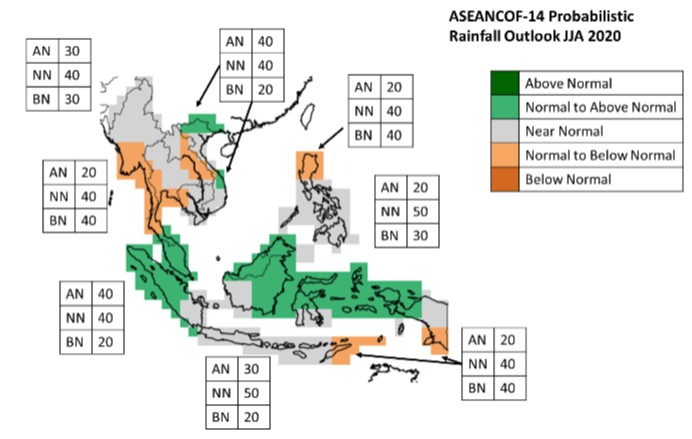18 JUN 2020
ASEANCOF
The Fourteenth Session of the ASEAN Climate Outlook Forum (Online Correspondence, 21 May 2020)

Participants of the Fourteenth Session of the ASEAN Climate Outlook Forum. Many participants joined from their own homes, while some NMHSs were able to participate from the office.
Introduction
The Fourteenth Session of the ASEAN Climate Outlook Forum (ASEANCOF-14) took place online on 21 May 2020 coordinated by the ASMC. Representatives from the ASEAN National Meteorological and Hydrological Services (NMHSs: Brunei, Indonesia, Malaysia, Myanmar, Philippines, Singapore, Thailand, and Viet Nam), along with experts from the World Meteorological Organization (WMO) and Regional Integrated Multi-Hazard Early Warning System for Africa and Asia (RIMES), joined together online to discuss the outlook for June-August 2020.
Climate Outlook Forum Proper
ASEANCOF sessions for the June-August period are usually held online, which conveniently meant that participants were already prepared for the various safe-distancing measures put in place for COVID-19. Prior to the meeting, the NMHSs filled out a detailed questionnaire which included questions on the upcoming boreal summer monsoon season’s outlook for rainfall and temperature, the outlook for important climate drivers (e.g. ENSO and IOD), and a review of the previous December 2019 – February 2020 outlook. During the online meeting, the participants discussed the responses before coming to a consensus for Southeast Asia as a whole.
The new format of the seasonal rainfall outlook for ASEANCOF. The gridded format allows for easier incorporation of model data as well as verification of the outlooks afterwards.
Developing Objective Seasonal Outlooks
This session also had a focus on developing objective seasonal outlooks. The WMO Guidance on Operational Practices for Seasonal Forecasting highlights the need for climate outlook forums to have forecasts that are producible, and in a digital format so that they are accessible to different applications and easily verifiable. During the session, Dr Wilfran Moufouma-Okia, WMO, and Dr G. Srinivasan, RIMES, presented the steps recommended to generate objective outlooks and the progress of various international climate outlook forums on this aspect.
ASEANCOF-14 also took two steps closer to objective seasonal outlooks. Firstly, a gridded multi-model ensemble from the WMO Lead Centre for Long-Range Forecasting was used as the basis for the seasonal outlooks. This first step is reproducible, and it also ensures that the consensus discussions are founded on science. The new gridded digital format also allows for easier verification of the seasonal outlooks – the second step closer towards objective outlooks. Subsequent ASEANCOFs will continue to move closer to objective seasonal outlooks.
The meeting concluded with a group photo of the participants. As evident from the photo, some NMHSs were able to join in from their office, while other participants were working from home. While the participants agreed that the discussions were fruitful, many were looking forward to the next physical meeting, which may now have to wait until 2021. On a positive note, a longer time before the next physical meeting gives those involved in ASEANCOF more time to experiment on and develop objective seasonal outlooks.
The ASEANCOF Consensus Statement for JJA 2020 can be found here.